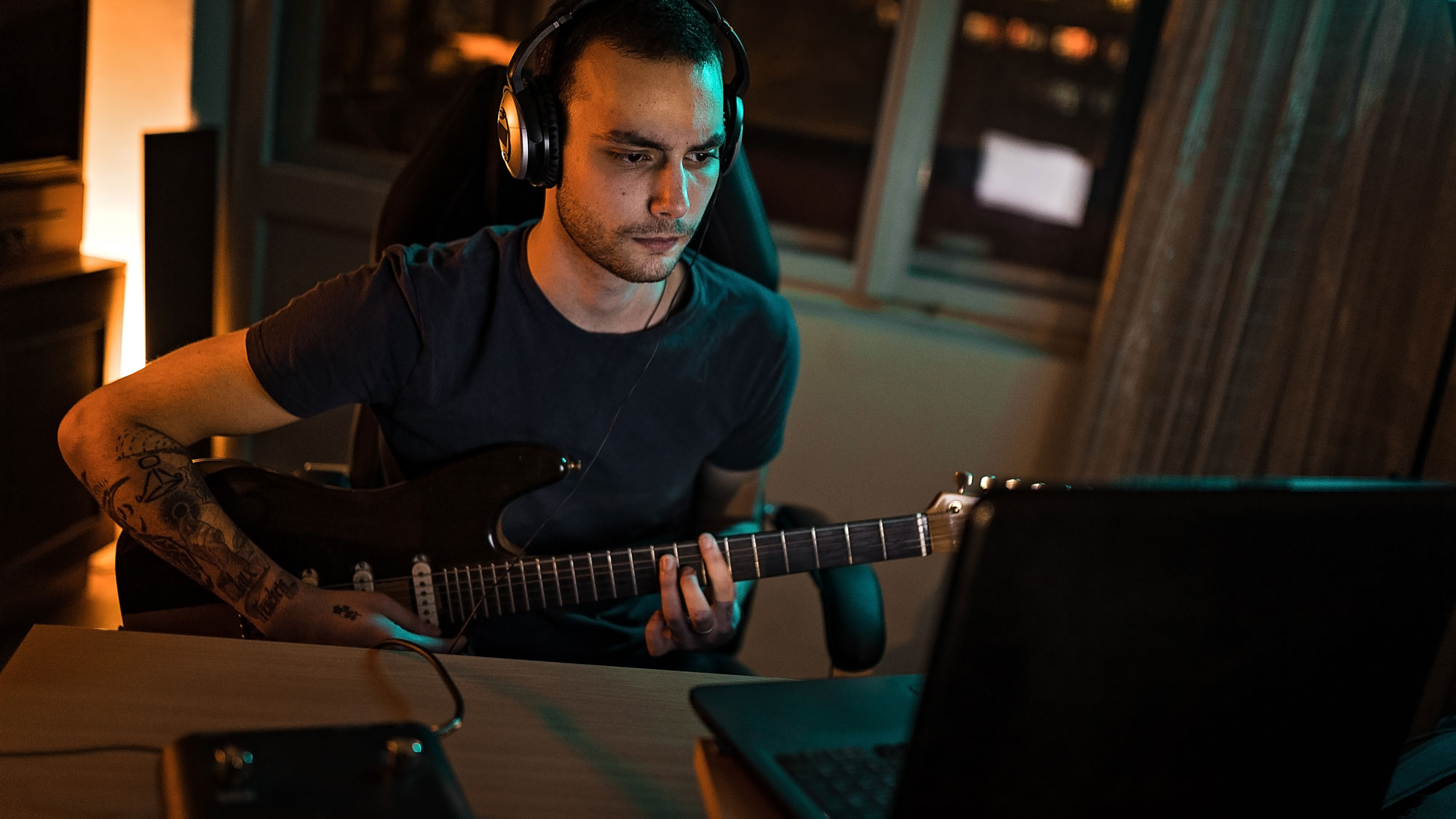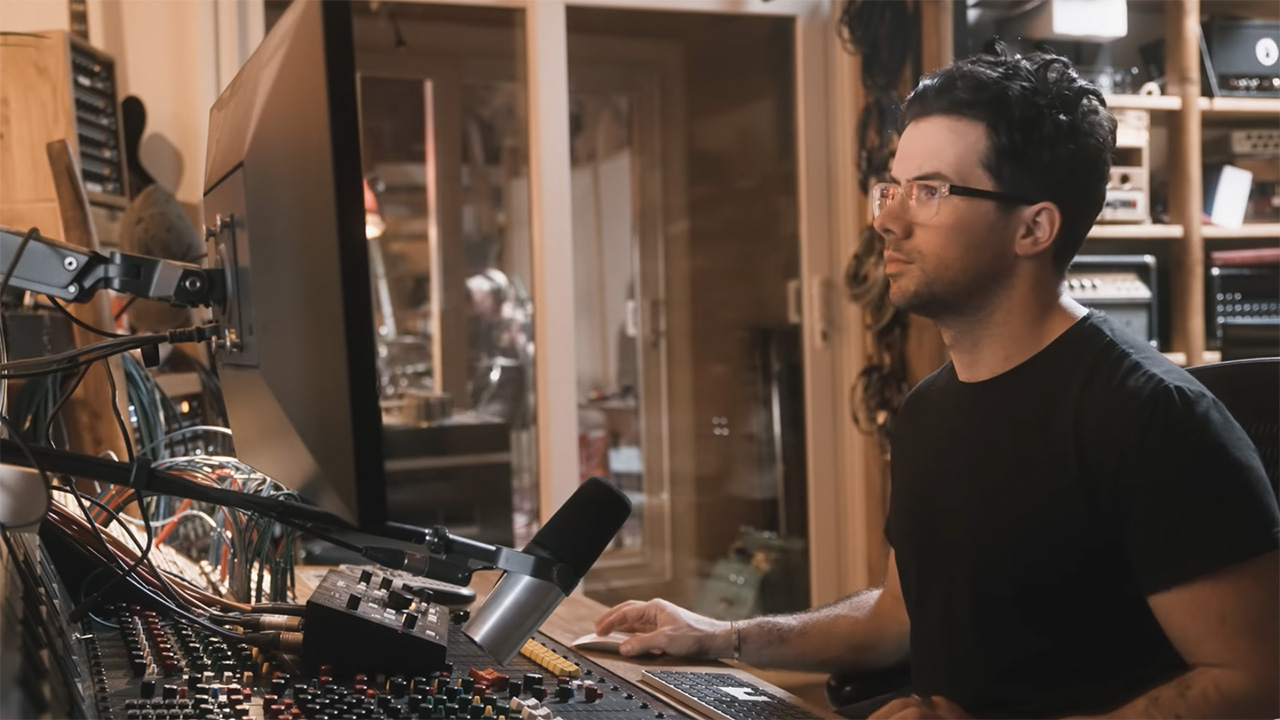“You should be recording your guitars with a DI so your tone can be rescued if needed”: Sleep Token and Tesseract’s mixing engineers reveal how to improve your guitar recordings – and it starts with ditching your ego
George Lever and Forrester Savell have worked with some of metal’s biggest names, and now they’re offering you advice on getting the most out of your bedroom productions before, during and after you’ve pressed record

Gone are the days of the inferior bedroom producer. As production gear and software becomes ever-more affordable, spare rooms become more viable alternatives to Abbey Road. Whether your homemade productions are for sharing with bandmates, seducing industry professionals or official releases, the tech is more accessible than ever – but making your music stand out in a saturated market isn’t.
With so many variables to self-recording and mixing guitars, as well as a raft of conflicting information online, Guitar World sat down with esteemed producers George Lever (Sleep Token, Loathe, Monuments) and Forrester Savell (Karnivool, Tesseract, Caligula’s Horse) to learn about what to do, and what not do, to make your productions pop.
Before recording
Like everything, preparation is key. Savell stresses the importance of players learning their parts before entering a recording environment; but Lever goes one step further by emphasizing the value of players “understanding their instrument to the best of the ability”.
He says: “There’s an assumption that recorded guitar should sound like MIDI, but that ignores the builds of different guitars – the way it's set up, the string tension relationship with the tuning that you’re playing in, and how the left-hand influences microtonal changes to the tuning.
“Or whether the pickups can perform in the way you want them to. The best thing someone can do before hitting record is become the most intuitive musician that they can, based on what they want to achieve with their instrument.”
He also recommends tuning to a piano at full volume, rather than relying on a tuner, as they “don’t tell you about the variation that might be occurring above and below the pick attack, or during the sustain.” He adds: “When tuning to a piano note, you can hear how in tune you are versus the piano – that’s why you’ll see orchestras tuning to each other.”
Safety first
Savell says bedroom producers can be guilty of “poor tonal choices,” so it’s important to set up a get-out-of-jail-free card. “As a safety mechanism you should be recording your guitars with a DI so that your tone can be rescued if needed.”
Get The Pick Newsletter
All the latest guitar news, interviews, lessons, reviews, deals and more, direct to your inbox!
You also want a suitable gain level. If it’s too loud there’s the risk of clipping, which is a difficult thing to fix. But if you overcompensate, a recording may include too much of the electrical noise inherent in guitars, cables and pedals. Says Lever: “I’ll make the loudest sound I can make on the guitar until it doesn’t clip on a preamp, then go back one notch.”

Setting the tone
In order to avoid the tone-chasing rabbit hole while recording, familiarity outranks experimentation. “Always record with a guitar sound you like,” Savell says. “It’s good for comfort and it also gives mixing engineers – if you’re going to work with one – a reference point if they want to build new tones.”
If you’re demoing your new track with your favorite tone, how should you dial in the double track’s tone? Savell says it comes down to trial and error, but adds: “There are characteristics of different amps and tones that I find work well together.
The more guitar performances you start stacking on top of each other, the smearier they can become
Forrester Savell
“A high-gain, smooth-sounding amp like a Peavey 5150 or Mesa/Boogie Dual Rectifier pairs well with a slightly backed-off breakup amp like a Marshall. It gives you a combination of saturation and a more percussive sound.”
Lever’s approach is a little more streamlined: “You can’t use one rule for everything: add what you think is missing from that first tone. You don’t want to compromise either tone.”
Less is more
Both engineers agree that recording more guitars isn’t necessarily conducive to a bigger, punchier sound. “Quad tracking is something that I only really do when I know that the guitarist is exceptionally tight,” Savell says. “The more guitar performances you start stacking on top of each other, the smearier they can become – you lose the articulation of what’s being played.
Lever adds: “Instead of tracking more of the same, I’d be thinking about playing something different with other layers, like higher or lower octaves, ambient or lead parts to fill out the sound. Then it becomes more melodious and interesting.”
Tracking
Recognizing that many of us record their demo parts in isolation, Savell stresses that it’s “important to listen to what the other instruments are playing. If each member records to an earlier demo version, they’re not bouncing off each other’s performances – it gets a little stale and things can fall out of sync.”
Asked if it’s better to aim for fluid takes or a more fragmented approach, Lever says: “It comes down to how shit the guitarist is. If it sounds good, then I don't care. There’s a lot of ego involved in recording, but that’s often for the musician on their own. The person who ends up enjoying the music doesn’t give a fuck about how you recorded it.”

Editing
As technology improves, it becomes easier to salvage a poor take or rescue an ear-bleeding tone. But therein lies another pitfall: precision editing can starve takes of their character.
“I like to keep the drums and bass nice and tight, but I’ll leave the guitars quite unedited unless they’re out of time or out of tune,” says Savell. “The guitars are where you can re-inject an organic feel to the song.
“Distorted guitar tones can get pretty gnarly up in the higher frequencies, to the point that you can hear if too many notches have been made with the EQs. It can be detrimental.”
How do I use EQ?
Savell offers a jargon-free explanation of what guitarists should be looking for when they pull up their guitar’s EQ.
“It's going to depend on the voicing of the guitar part,” he explains. “If it's a low, heavy rhythm part, you might be concerned about how much body and bottom end is in there.
“You might want to take some of the low-end out so it doesn’t flood the mix. With high parts, you might want to remove some of the harshness by taking some high-end out.
“The first thing I’d always be trying is volume – finding that point where the guitar is audible. Then I’d approach it as more of a subtractive EQ approach to remove the parts of the frequency spectrum that aren’t necessary.”
Mixing and panning
Once guitars are tracked, finding a spot in the mix where they shine can be a real headache. “Guitars are always slightly above cymbals but below vocals,” Lever says. “That’s the pocket they’re given because they sit on the extremes of the stereo image.
“The thing they’re going to come into contact with the most when mixing is cymbals. But the cymbal information that takes up the area the guitars are in is not very musical; it can be quite brash. You don’t need to hear it.”
Panning can be a great way to make things stick out
Forrester Savell
Both engineers hard-pan rhythm guitars, meaning they’re put as far out on either side of the mix as possible. Lever only changes that “if you intentionally want to make the song smaller” – a quiet verse section, for instance. This can also help make other sections sound even bigger.
“Where you pan ambient layers and lead layers is going to depend on other elements in the mix,” Savell says. “I’ll pan them to where I’ll hear them best; you don’t want two different tracks to compete for the same sonic spaces. You especially want to put ambient guitars in the holes of the mix to fill in the sonic spectrum.”

What to do when a guitar doesn’t cut through the mix
You nailed the take, but you can’t hear it in the mix. How do you troubleshoot? “Panning can be a great way to make things stick out,” says Savell. “If you've got one guitar in the middle, as soon as you start to move it off to the side, it instantly gets more attention because it becomes asymmetrical.
“The other thing I’d ask if it’s not standing out is, ‘Is it the right part? Is there something that would carry that moment better?”
Lever predicts the drum track will usually be the main issue. “If you still can’t hear the rhythm guitars in the side signal [the isolated side of the mix where the guitar sits] then you’ve likely got something that’s masking or clouding them. A lot of the time it’ll be cymbals covering up the guitar attack and aggression.
“People often misunderstand the usefulness of the midrange. You can have a scooped guitar tone but still have midrange in place. That carries across all sound systems and anchors the position of the guitars in the mix.”
Is it better to mix with headphones or speakers?
“Headphones are essentially just microscopes,” Lever argues. “Speakers offer a larger picture view. It’s about understanding how each one complements the other.”
For Savell, “the most important thing is to do whatever you’re comfortable with. If you’re making and listening to other music in the same space, you’re probably going to have a pretty good idea of how things are meant to sound. It’s only when you're not confident that you need to throw on the headphones for more detail.”
It would be silly to not check your mix with AirPods. But don’t mix specifically for them
George Lever
As Lever points out, guitarists need not get bogged down in thinking they need the priciest monitors available to mix on. It’s unlikely your listener will be afforded such luxuries at the other end.
“The most commonly used headphones are the wireless AirPods now, so they’re the reference stage for music at this moment in time,” he says. “It would be silly to not check your mix with them. But don’t mix specifically for them; the likelihood is the people that are listening on these headphones don’t care.”
Which section should I mix first?
When it comes to mixing order, it’s all about context. “I start on the bit that I’m vibing on, because that’s the section that excites me, and I’ll get creative with it,” Lever states. “If I get it sounding good, it gives me perspective on how the other sections should sound.”
“I play it through to understand the whole song,” Savell says. “Then I’ll start with the section that needs to have a very specific energy, like a breakdown. It's very easy to make a chorus feel big or to make an intro sound small – but it's very difficult to make something feel like it has an impact if things aren't set up in the right way. So, cherry-pick what the most important moment is.”
Should I get my releases professionally mixed?
On the subject of working with a mixing engineer, Lever says it’s all about your own intent and mindset. “If you don't value what a person is going to bring to the table, then there's no point working with them,” he states – but underlines that collaborating with the right people can help your music cut through a saturated market.
“When it comes showcasing your music, remove your ego and understand that most people are only ever going to listen to your song once before moving on. So how can you stand out and stay there?
If you took on all the roles in another creative industry, you’d be seen as a madman
George Lever
“There are a lot of people that believe that they have to be the songwriter, producer, mixer and mastering engineer. But if you took on all the roles in another creative industry, you’d be seen as a madman.
“You do not know what happens as a result of collaboration,” he concludes. “You definitely know what happens if you stay stuck in your bedroom.”
A freelance writer with a penchant for music that gets weird, Phil is a regular contributor to Prog, Guitar World, and Total Guitar magazines and is especially keen on shining a light on unknown artists. Outside of the journalism realm, you can find him writing angular riffs in progressive metal band, Prognosis, in which he slings an 8-string Strandberg Boden Original, churning that low string through a variety of tunings. He's also a published author and is currently penning his debut novel which chucks fantasy, mythology and humanity into a great big melting pot.
"Brilliantly precise monitoring headphones with wide open-back sound": Audio-Technica ATH-R70XA review
“We’ve painstakingly restored Les Paul’s original gear”: The Les Paul Recording Studio opens in Hollywood – bringing the innovator’s revolutionary gear to a whole new generation of musicians














